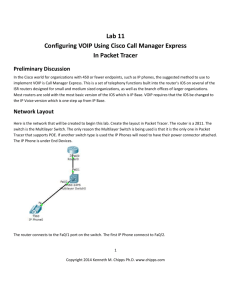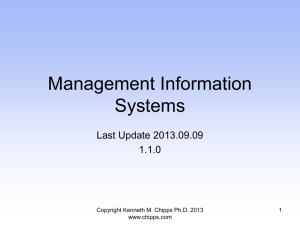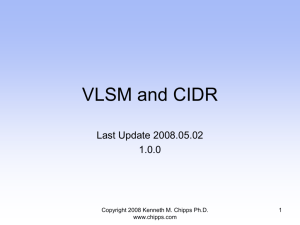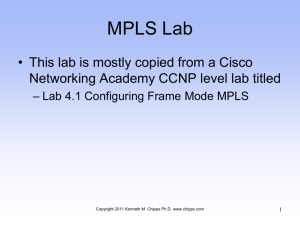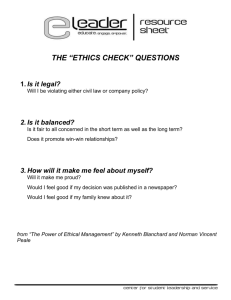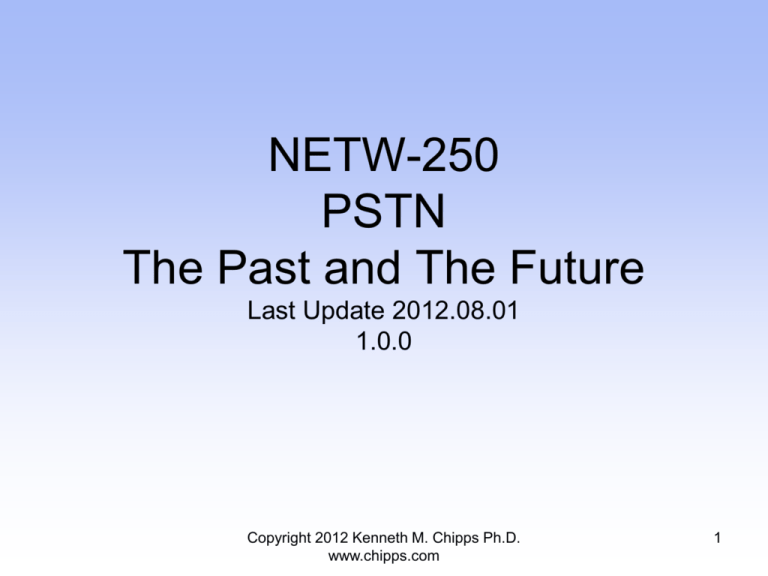
NETW-250
PSTN
The Past and The Future
Last Update 2012.08.01
1.0.0
Copyright 2012 Kenneth M. Chipps Ph.D.
www.chipps.com
1
Telephony
• Telephony is the communication of spoken
information between two or more
participants
• These days this is commonly done in
whole or at least always in part over the
PSTN
Copyright 2012 Kenneth M. Chipps Ph.D. www.chipps.com
2
The PSTN
• The PSTN is the Public Switched
Telephone Network first deployed in the
1880s
• Traditional wired landlines as used by the
PSTN peaked in about 2000 at
192,512,992 according to Google
• They have been in decline ever since as
more and more households use only a
cellular phone connection
Copyright 2012 Kenneth M. Chipps Ph.D. www.chipps.com
3
The PSTN
• Here is a nice illustration of this from
Google
Copyright 2012 Kenneth M. Chipps Ph.D. www.chipps.com
4
The PSTN
Copyright 2012 Kenneth M. Chipps Ph.D. www.chipps.com
5
The PSTN
• These wireless calls are only wireless over
the last mile or the distance from the user
to the cell tower
• From the cell tower it is back to the
traditional wired PSTN
Copyright 2012 Kenneth M. Chipps Ph.D. www.chipps.com
6
The PSTN
• As such the PSTN will not disappear as
fiber optic cables are much better than the
older style microwave radio frequency
backhauls that were once used to carry
long distance calls across the country
Copyright 2012 Kenneth M. Chipps Ph.D. www.chipps.com
7
The PSTN
• The problem for the PSTN is the last mile
• This is the connection from the customer
to the local telephone office
• The only thing that will save the landline
over the last mile is for the ILECs to
replace the copper with singlemode fiber
optic cable
Copyright 2012 Kenneth M. Chipps Ph.D. www.chipps.com
8
The PSTN
• Verizon has done this with their FIOS
service as has AT&T with the U-verse
offering
• The problem is these are limited
deployments
Copyright 2012 Kenneth M. Chipps Ph.D. www.chipps.com
9
History of Communication
• Let’s look the development of long
distance communication and how the
PSTN was developed, before we spend
the rest of the course seeing where it is
going
• This order of events is from the lecture
notes of James Sterbenz of the University
of Kansas from 2011
Copyright 2012 Kenneth M. Chipps Ph.D. www.chipps.com
10
Human Messengers
• The first form of long distance
communication as reported in the earliest
historical records was the use of
messengers to travel from point to point
such as the run by a messenger from
Marathon to Athens to announce the
Greek victory over the Persians
Copyright 2012 Kenneth M. Chipps Ph.D. www.chipps.com
11
Horse Mounted Messengers
• Along with humans on foot, horse
mounted messengers were used as well
• This could be as a single messenger or as
part of a sequence of riders between
established stations
• Over time this turned into a postal service
around 1200 in China
• In the US this was seen in the Pony
Express
Copyright 2012 Kenneth M. Chipps Ph.D. www.chipps.com
12
Horse Mounted Messengers
• Here is a map of this route from the lecture
notes of James Sterbenz of the University
of Kansas
Copyright 2012 Kenneth M. Chipps Ph.D. www.chipps.com
13
Horse Mounted Messengers
Copyright 2012 Kenneth M. Chipps Ph.D. www.chipps.com
14
Carrier Pigeons
• In addition to horses, carrier pigeons were
used from ancient times as well
• Not to jump too far ahead but be sure you
examine RFCs 1149, 2549, and 6214 in
relation to the current use of this
transmission method
Copyright 2012 Kenneth M. Chipps Ph.D. www.chipps.com
15
Telegraph
• Several forms of telegraphs have been
developed over the centuries
• Let’s look at these
Copyright 2012 Kenneth M. Chipps Ph.D. www.chipps.com
16
Beacons
• Beacons of various forms have been used
since ancient times in the form of fire
beacons, smoke signals, and most well
know Chappe’s semaphore signals from
1794
• First an illustration from Wikipedia of the
Chappe system and then the layout of the
network from Sterbenz
Copyright 2012 Kenneth M. Chipps Ph.D. www.chipps.com
17
Beacons
Copyright 2012 Kenneth M. Chipps Ph.D. www.chipps.com
18
Beacons
Copyright 2012 Kenneth M. Chipps Ph.D. www.chipps.com
19
Beacons
• Edelcrantz improved on Chappe’s system
when he introduced the optical shutter
method
• More modern forms of this system are the
light shutter system used for ship to ship
communication in the 20th century
Copyright 2012 Kenneth M. Chipps Ph.D. www.chipps.com
20
Flag Signals
• Flag based signaling systems appeared in
the 1800s
• These are were most commonly used
between ships
• Be sure to read RFC 4824 for more on this
in relation to packet transmission
• Here is an example from Sterbenz
Copyright 2012 Kenneth M. Chipps Ph.D. www.chipps.com
21
Flag Signals
Copyright 2012 Kenneth M. Chipps Ph.D. www.chipps.com
22
Electric Telegraphs
• With the mastery of electricity the
telegraph became possible
• This was an important advance as the
telegraph did not require line of site
• Worldwide communication became
possible with the laying of oceanic cables
• Telegrams are similar to email messages
Copyright 2012 Kenneth M. Chipps Ph.D. www.chipps.com
23
Radio Telegraphy
• With the development of telegraphy over
radio waves the distances could be
increased
• Wires were no longer needed
Copyright 2012 Kenneth M. Chipps Ph.D. www.chipps.com
24
PSTN
• The next advance in communication was
the development of the telephone and the
subsequent PSTN – Public Switched
Telephone Network
• The PSTN developed from the original Bell
Telephone Company formed by Alexander
Graham Bell and his business partners in
1877
Copyright 2012 Kenneth M. Chipps Ph.D. www.chipps.com
25
The Bell System
• The first telephones were directly
connected to each other
• It became obvious very quickly that this
would not scale well
• The solution was to run all wires to a
central point
• The first Bell system exchange went into
operation in 1878 in New Haven
Connecticut
Copyright 2012 Kenneth M. Chipps Ph.D. www.chipps.com
26
The Bell System
• By 1878 most major urban areas had a
telephone exchange that operated under a
license from the Bell System
• In this period before Bell's second patent
expired in 1894, only Bell Telephone and
its licensees could legally operate
telephone systems in the United States
Copyright 2012 Kenneth M. Chipps Ph.D. www.chipps.com
27
Competition
• With the expiration of the patent the
number of phone companies grew to over
six thousand by 1904
• The number of telephones in operation
went from 285,000 to 3,317,000
• This large number of telephone companies
created a new set of problems such as the
interconnection of customers to different
telephone companies
Copyright 2012 Kenneth M. Chipps Ph.D. www.chipps.com
28
The Bell System
• From its formation the Bell system sought
to gain control of the entire US telephone
network
• Over time they were able to do this
• This form was maintained until 1984
• In its final form AT&T consisted of
– The AT&T company with its long distance
operation
Copyright 2012 Kenneth M. Chipps Ph.D. www.chipps.com
29
The Bell System
– The 22 operating companies providing local
service in their area of the country
– Western Electric providing the equipment
– Bell Labs providing the research arm
• In all AT&T constituted a complete vertical
monopoly of the PSTN which by this time
had become the dominate form of
communication
Copyright 2012 Kenneth M. Chipps Ph.D. www.chipps.com
30
Kingsbury Commitment
• In the period from 1877 to 1984 the Bell
company came under increasing degrees
of oversight by the government
• The first time the government restricted
the actions of AT&T was the Kingsbury
Commitment from 1913 that recognized
AT&T as a regulated monopoly
Copyright 2012 Kenneth M. Chipps Ph.D. www.chipps.com
31
Kingsbury Commitment
• A regulated monopoly is allowed to
provide a service without competition, but
with oversight and some constraints on
exactly what it can offer
• In this case the government set the rates
• Other natural monopolies are
– National Defense
– Sewer Service
– Postal Service, at least for letters
Copyright 2000-2003 Ken Chipps All Rights Reserved
32
Kingsbury Commitment
• The idea behind a natural monody is that
control by a single entity is the best way to
deliver a service, but that these
monopolies need to be watched
• There were other smaller PSTN
companies but AT&T was by far the
dominate and only nationwide PSTN
company
Copyright 2012 Kenneth M. Chipps Ph.D. www.chipps.com
33
Graham-Willis Act of 1921
• This commitment was an agreement with
AT&T, not legislation
• The Graham-Willis Act of 1921 formalized
the Kingsbury Commitment in legislation
Copyright 2000-2003 Ken Chipps All Rights Reserved
34
Communications Act of 1934
• The regulatory environment we see today
started in 1934 with the Communications
Act of 1934
• This legislation grew out of the GrahamWillis Act of 1921
• In addition to being a natural monopoly, it
was recognized that this monopoly
required at least some regulation
Copyright 2000-2003 Ken Chipps All Rights Reserved
35
Communications Act of 1934
• This watching was done by the FCC Federal Communications Commission
• The government let AT&T be that
monopoly
Copyright 2000-2003 Ken Chipps All Rights Reserved
36
Growth of the PSTN
• By 1945 fifty percent of US households
had phone service
Copyright 2012 Kenneth M. Chipps Ph.D. www.chipps.com
37
1956 Consent Decree
• Things were fine until the 1950s
• From the 1930’s through the early 1950’s
the FCC decided that AT&T was getting
out of hand
• After much argument – note the 1956 date
– the FCC got to more closely regulate
AT&T
• AT&T got a monopoly over most long
distance service as their part of the deal
Copyright 2000-2003 Ken Chipps All Rights Reserved
38
Hush-a-Phone Decision
• The first attempt to penetrate this
monopoly was the Hush-a-Phone decision
from 1956 that forced AT&T to allow
equipment other than that provided by
Western Electric to be attached to the
PSTN
• In this case it was just an attachment to
AT&T equipment
Copyright 2012 Kenneth M. Chipps Ph.D. www.chipps.com
39
Carterphone Decision of 1968
• The first hole in the natural monopoly held
by AT&T appeared in the 1960s
• The Carterphone company decided to
make a device, that they would sell directly
to phone users, that would use AT&Ts
natural monopoly network
• AT&T said no, no, no
• We have a monopoly on making stuff that
plugs into the network
Copyright 2000-2003 Ken Chipps All Rights Reserved
40
Carterphone Decision of 1968
• The courts said yes, anyone could make
equipment for the telephone network
• This allowed everyone to make stuff to
attach to the phone company network,
which they do now
Copyright 2000-2003 Ken Chipps All Rights Reserved
41
Full Service
• By 1969 ninety percent of US households
had PSTN service which is as close to
universal service as possible
Copyright 2012 Kenneth M. Chipps Ph.D. www.chipps.com
42
Modification of Final Judgment
• Judge Harold Greene messed up this nice,
well organized, and understandable
arrangement in 1984
• He decided that the phone system was not
a natural monopoly
• The result of this decision was the breakup
of AT&T
Copyright 2000-2003 Ken Chipps All Rights Reserved
43
Modification of Final Judgment
• Now we have
– ILECs
– CLECs
– and so on
Copyright 2000-2003 Ken Chipps All Rights Reserved
44
Telecommunications Act
• To spur on competition, the Congress
decided to pass the Telecommunications
Act of 1996
• This act decided that everyone should be
in everyone else’s business, just as soon
as everyone else was in all the other
businesses
• Confusing isn’t it
• So is this act
Copyright 2000-2003 Ken Chipps All Rights Reserved
45
Telecommunications Act
• Basically it lets any company do anything
• It was meant to give everyone full choice
by promoting competition
• More specifically the legislation was
supposed to
– Open local service to competition
– Let the regional Bell operating companies
provide long-distance service
– Deregulate some cable rates
Copyright 2000-2003 Ken Chipps All Rights Reserved
46
Telecommunications Act
– Let local telephone companies sell video
services
– Protect Universal Service
– Change broadcast ownership rules
Copyright 2012 Kenneth M. Chipps Ph.D. www.chipps.com
47
Why Doesn’t Competition Exist
• The problem with the 1996
Communications Act is nothing changed
• The ILECs still control the last mile
• Real competition does not exist
• For example, the ILECs say they cannot
charge enough to cover their costs and
still rent access to the customer
connection for a reasonable rate
Copyright 2000-2003 Ken Chipps All Rights Reserved
48
The Current PSTN
• After all of this the PSTN now consists of
three companies that control it
– Verizon
– AT&T
– Qwest
• Is this starting to look like the original
AT&T monopoly all over again
Copyright 2012 Kenneth M. Chipps Ph.D. www.chipps.com
49
Limits of Traditional Telephony
• While working well for over 100 hundred
years the PSTN has some disadvantages
in today’s telecommunications market
– New features take a while to roll out
– New features usually require new hardware
– There are capacity and cost constraints
– Data has overtaken voice as the main driver
of traffic
Copyright 2012 Kenneth M. Chipps Ph.D. www.chipps.com
50
Voice or Data
• By mid 2000 the PSTN designed for voice
was carrying more data than voice traffic
• Of course the PSTN had from the earliest
days carried more than just voice
• In the 1920s radio programs and wire
photos began to be carried
• In the 1930s teletypewriter service sent
text as digital signals
Copyright 2012 Kenneth M. Chipps Ph.D. www.chipps.com
51
Voice or Data
• Television was sent over the wires in the
1940s
• By mid 2000 more data was carried than
voice over the PSTN
Copyright 2012 Kenneth M. Chipps Ph.D. www.chipps.com
52
Transition of the PSTN
• In 1958 modems allowed computers to
transmit digital data over voice grade
analog telephone circuits
• At this point computers were still
mainframe based networks owned by a
few companies
• By the late 1970s the transmission of
digital data increased dramatically
between these networks
Copyright 2012 Kenneth M. Chipps Ph.D. www.chipps.com
53
Transition of the PSTN
• Then in the 1980s with the rise of personal
computers and local area networks the
need to send data over the PSTN
increased rapidly every year
• The origins of the Internet began in 1969
with the ARPANET funded by the
Advanced Research Projects Agency of
the Department of Defense
Copyright 2012 Kenneth M. Chipps Ph.D. www.chipps.com
54
Transition of the PSTN
• This was the first standards based
internetwork
• Unlike the proprietary networks that only
allowed transmission of data between
machines of the same company the
ARPANET was designed to interconnect
any type of device
Copyright 2012 Kenneth M. Chipps Ph.D. www.chipps.com
55
Transition of the PSTN
• The first connected nodes were UCLA,
Stanford Research Institute, University of
California at Santa Barbara, and University
of Utah
Copyright 2012 Kenneth M. Chipps Ph.D. www.chipps.com
56

